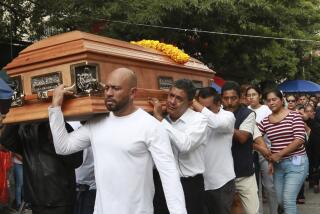Curtailing Youth Crime a 2nd-Term Goal, Clinton Says
- Share via
WASHINGTON — President Clinton said Saturday that a crime-fighting priority of his second term will be combating youth violence and drug abuse, particularly threats posed by juvenile gangs and intimidation of witnesses by gang members.
“I am determined to break the backs of criminal gangs that have ruined too many lives and stolen too many futures by bringing the full force of the law against them,” the president said in his weekly radio address.
Clinton said that “in the coming weeks I will submit to Congress comprehensive legislation” to address the problem, including efforts by gang leaders to intimidate witnesses who could help prosecute them.
Although administration officials did not spell out details, they said the bill is likely to restate some proposals included in the 1996 Anti-Gang and Youth Violence Control Act that died in the last Congress.
That bill would have allowed juveniles to be prosecuted as adults for drug conspiracy, violent crimes and offenses involving guns. It also would have established a national gang-tracking network for more efficient exchange of investigative data among federal, state and local law enforcement agencies.
A White House aide said last year’s anti-gang-violence bill, which had Sen. Dianne Feinstein (D-Calif.) as a principal sponsor, was not given a high-enough priority by Congress and “never even had a hearing. . . . We believe the atmosphere for such legislation is more favorable now.”
Orange County authorities on Saturday welcomed the president’s emphasis on gang crime.
“This is a very important focus, and I hope that we see some money going to our city,” said Santa Ana Councilman Ted R. Moreno. “Any time we can combat and bring down crime, especially youth crime, it’s going to be a benefit [to] our community.”
Santa Ana already has launched an aggressive anti-gang effort, including a federally funded program to revitalize troubled neighborhoods and a police program targeting gang leaders. But Moreno said the city could use more money to increase law enforcement and support youth programs.
“I think it’s a crisis right now, and the assistance is needed,” said Los Angeles Councilman Mike Hernandez, who represents the most gang-plagued district in that city. “There’s no question in my mind that the police are being outmaneuvered by gangs.”
Clinton also said he has asked Atty. Gen. Janet Reno to recommend measures to fight the problem of gang intimidation of witnesses to prevent them from providing evidence or testimony that would aid in the prosecution of gang members.
“We must not allow the very gangs we are fighting to grind the wheels of justice to a halt,” Clinton said.
The president’s address coincided with the release of a Justice Department report that said 88% of the nation’s largest cities and 56% of smaller communities suffer from gang-related crimes.
Nowhere is the problem more acute than Los Angeles County, often cited at the nation’s gang capital, with more than 150,000 gang members and 1,200 street gangs. Though the county’s murder tally has been falling and gang assaults are down from highs of the early 1990s, gang slayings hit a record in 1995. They now account for nearly half of all the county’s homicides.
Witness intimidation in cases involving gangs and drugs has been hampering many criminal prosecutions, the Justice Department report said.
The report called on prosecutors and police to develop better witness-security programs, noting that gang members and people known to a witness often show up in court in an effort to intimidate a witness.
California and other states permit judges to remove spectators from courtrooms when their presence seems aimed at intimidating witnesses, the report said.
Administration officials said proposed legislation would include new tools for federal and state prosecutors to investigate and prosecute gang members and help end intimidation of witnesses.
Michael Genelin, who heads the Los Angeles County District Attorney’s Hardcore Gang Division, said his agency supports many of the proposals in the Feinstein legislation that died in Congress last year.
“When you join the quantity of guns on the street and the number of gang members and their mobility, you see why the president is concerned,” Genelin said.
The witness-intimidation problems cited by the president are a recurring problem in Los Angeles County. “We need additional funding so that we can provide [local witnesses] the kind of blanket protection that the federal government can provide,” Genelin said.
Though Los Angeles’ program is one of the best in the state, he said, it is not set up to deal fully with the needs of people relocated for their protection, such as added transportation expenses to get to jobs.
Local officials also said deep-reaching efforts are needed to improve relationships between police and community, as well as increase networks of community support, so fearful witnesses will come forward and cooperate in gang investigations in the first place. Police frequently complain that investigations in gang-ridden neighborhoods often go nowhere because of lack of cooperation by residents.
“We have to have programs so the community feels empowered enough to cooperate and participate in creating a cohesive community,” Genelin said.
FBI figures show that juvenile crime, as well as overall violent crime, is on the wane. Reno has attributed the decline largely to close cooperation between the administration and state and local authorities, and the White House effort to put 100,000 more police officers on the street.
The president emphasized law enforcement and prosecution efforts. But to be truly effective, law enforcement must be complemented by additional long-term prevention and intervention efforts that address the root causes of the gang problem, experts and authorities agree.
A recent wide-ranging report on the state of street gangs in Los Angeles County stressed the need for a series of closely coordinated, neighborhood-by-neighborhood anti-gang consortiums of schools, police, prosecutors, community groups to begin breaking the grip of gangs in the region.
What most often has been lacking is a central individual or organization in each community who can pull disjointed programs together and keep them on track, the report by a countywide task force concluded.
In the Republican response to Clinton, Senate Majority Leader Trent Lott of Mississippi said GOP members of Congress will push for permanent tax cuts as part of their legislative agenda for “a better quality of life for all Americans.”
“We’re ready to bring about the changes America needs,” Lott said, adding that “it starts with your home, your workplace, your neighborhood. It starts with our belief that government should take less of what you earn, and that you should keep more of it.”
Referring to youth violence, Lott also said, “We want every child to have a chance for a good education, and a school free from violence and drugs.”
After delivering his address from the Oval Office, the president met for several hours with his incoming and outgoing Cabinet members at Blair House, across Pennsylvania Avenue from the White House.
Aides said the closed-door event included discussions of trade, national security, the budget, economic growth, preservation of American leadership in the world and domestic policies such as protection of the environment.
Leaving after 7 1/2 hours of discussion, Clinton pumped his fist skyward and called to reporters, “We’re ready to go on the 21st!”
Throughout the working sessions, the president emphasized “the need for us to work closely with Congress . . . to reach out, especially to the Republican leadership,” White House Press Secretary Mike McCurry said afterward.
Jackson reported from Washington, Lopez and Connell from Los Angeles.
More to Read
Sign up for Essential California
The most important California stories and recommendations in your inbox every morning.
You may occasionally receive promotional content from the Los Angeles Times.











